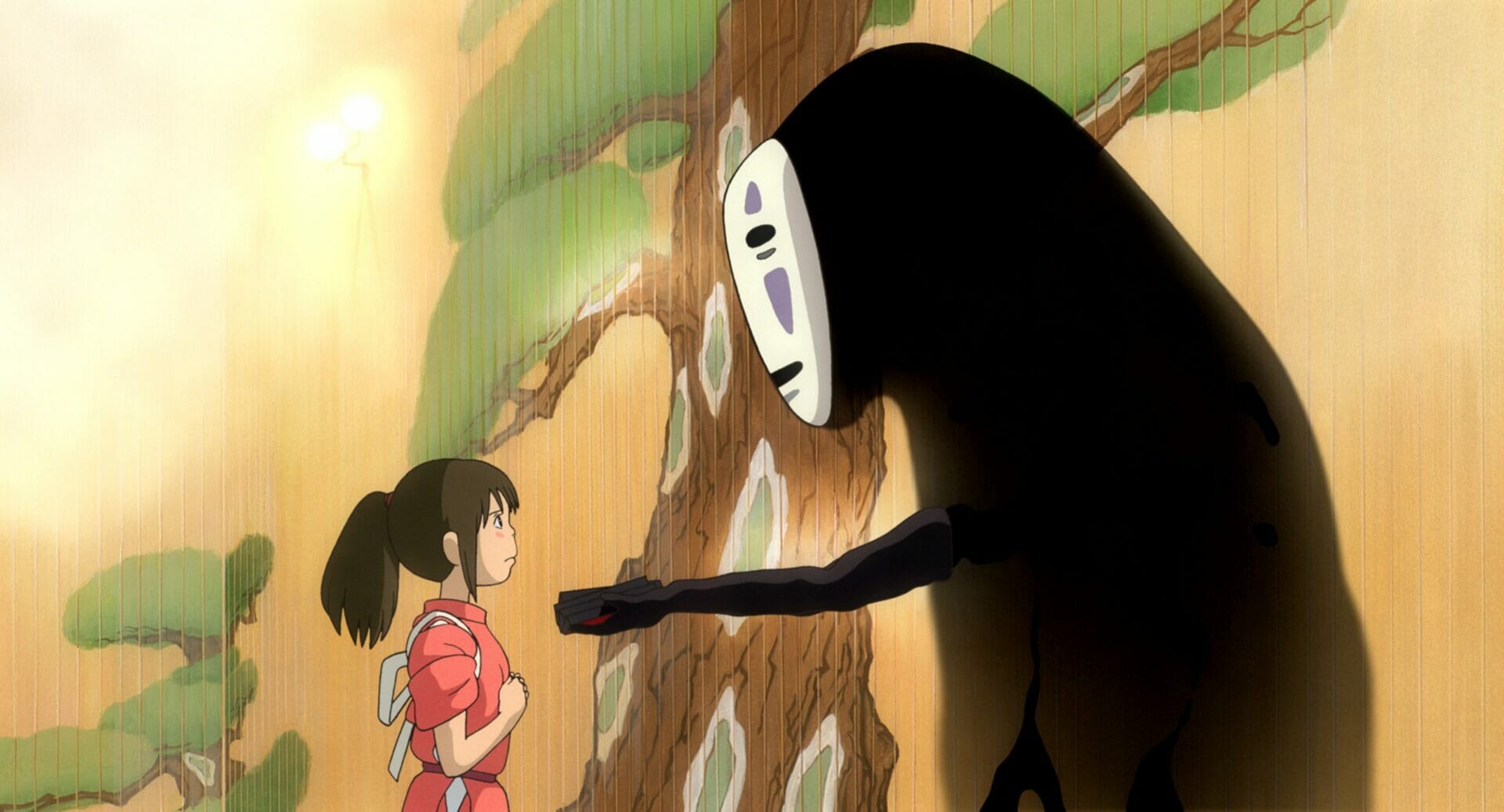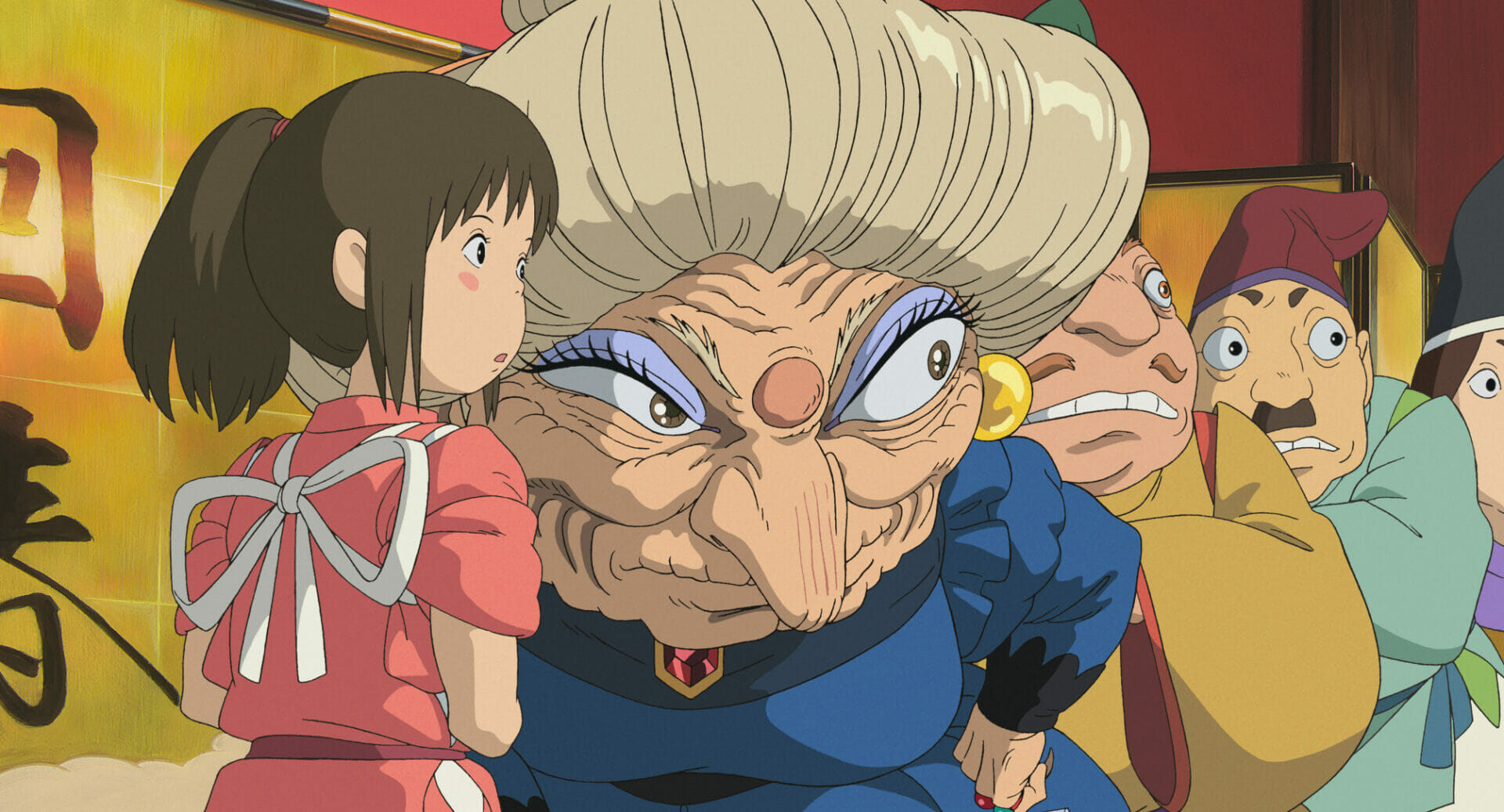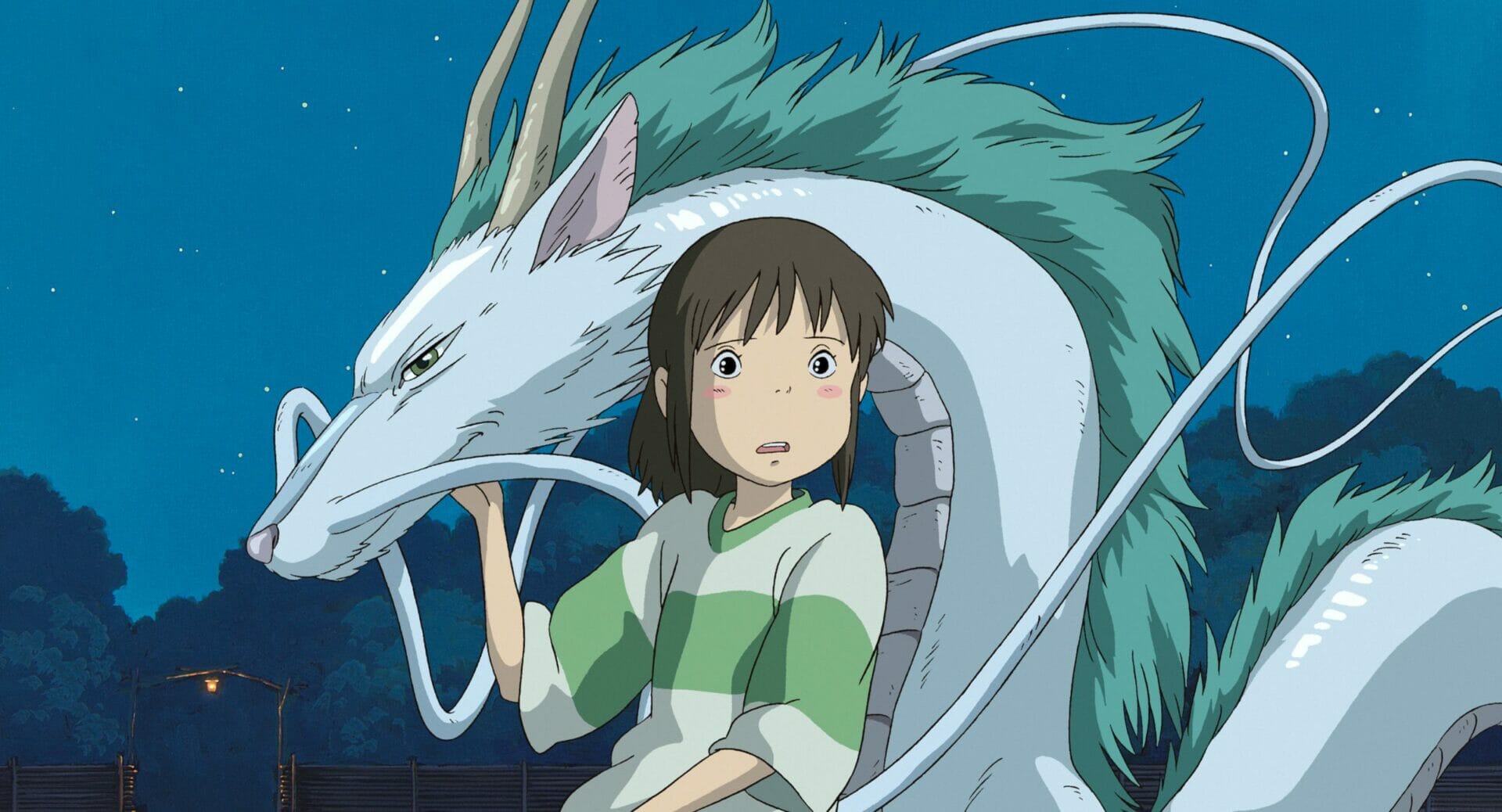
Spirited Away | An otherworldly journey for growing up
Year
Runtime
Director
Cinematographer
Production Designer
Music by
Country
Genre
Subgenre
Spirited Away (千と千尋の神隠し, Sen to Chihiro no Kamikakushi, literally translated to Sen and Chihiro’s Spiriting Away) is a Japanese fantasy animated movie written and directed by Hayao Miyazaki. It is the twelfth animation made by Studio Ghibli. It was released in 2001, unanimously acclaimed by critics all over the world.
Chihiro’s journey is a coming-of-age story set in a fantastical and traditional Japan. Through this movie, Miyazaki engages with younger viewers on issues such as changes in the environment and the protection of cultural heritage.
A journey into the spiritual realm
Spirited Away tells the story of Chihiro Ogino (voiced by Rumi Hiiragi), a ten-year-old girl, and her adventures in a mysterious world inhabited by gods, spirits, and witches. After a witch called Yubaba (voiced by Mari Natsuki) cast a curse on her parents and turns them into pigs, Chihiro is forced to work in an enchanted bathhouse in order to free them. There, she meets a boy named Haku (voiced by Miyu Irino), who will join her on a journey to understand who she is. The challenges Chihiro will face in this alienating place will transform her into a braver, more empathetic version of herself.
Creating a Wonderland
The animations in Studio Ghibli’s movies feel unique. Indeed, they are all hand-drawn and not computer-generated. However, in the early 2000s, Studio Ghibli opted to use 3D to create some technical and labor-intensive shots. These scenes often contain complex camera movements, such as the “tracking shots” of Chihiro running through the flower fields.
In Spirited Away, the daylight scenes use under-saturated and pastel colors. This palette conveys a sense of a soft, calm atmosphere. In contrast, the night-time scenes are imbued with mystery and threats that lie in dark corners. The transition heightens the blue and purple hues of the night, which contrast with the multitude of fluorescent lanterns. This color palette of warm pastel hues contrasting with dark, cool purples recalls Claude Monet‘s Nymphéas. To support the change of scenery, the mellow tunes shift to a more dramatic and grandiose beat at night. Composer Joe Hisaichi composed the soundtrack for Spirited Away, as well as all of Miyazaki’s other Studio Ghibli movies.
Seeing through Japanese eyes
Studio Ghibli creates Japanese animations that are very different from Western animations, such as Disney or Pixar movies.
In the latter, usually, child viewers see animations featuring charming faces and friendly protagonists. In particular, the female heroine is usually of high lineage and pretty, with large sparkling eyes, tiny noses, and small chins. This makes them appear innocent. Indeed, Disney movies have continued to reproduce old fairy tales centered on a female figure whose success is partly conditioned by her moral virtue and feminine beauty.
As a change from this, Hayao Miyazaki decided to make Chihiro look not as glamourous as typical Disney princesses. Instead, he wanted to focus on her abilities and the evolution of her personality. Also, the other characters she interacts with are creepy and quite terrifying. One cannot forget the apparition of No-Face, a character shaped like a shadow from the unconscious. Yet, No-Face is spine-chilling only because it is alone and does not have a sense of self. Hence, No-Face is appeased when he is invited to stay at the house of the twin witch Zeniba.

For adult viewers, one should approach Spirited Away by managing the cultural differences that carry underlying meanings. For example, the importance of the bathhouse, where all kinds of spirits come to relax. The practice of going to the onsen – the bathhouse – is still common in Japan. The ritual of bathing in hot springs serves not only to wash oneself but also to cleanse the mind and soul. Hence, that’s why one spirit in particular – the River Spirit – is freed from dirt and pollution after its visit to the bathhouse.
A magical fantasy to grow up with
Chihiro’s peripeteia is a coming-of-age story. On her way, she faces many challenges that test her courage, her morals, and her will to overcome her fears. The girl endures a traumatizing separation from her parents and starts working early on. This separation leads Chihiro to discover herself as she searches for her own voice and traces back her history.
First, she learns to master the power of words and to use her voice to make other people hear her out. For example, the witch Yubaba cannot ignore Chihiro’s repeated vocal demand to work. No-Face, who cannot express himself, struggles to be understood and therefore uses money and violence.
Later, the witch steals Chihiro’s name, naming her Sen instead. Yubaba also uses this spell to keep the boy Haku under her yoke. Indeed, Haku cannot go back to where he came from. Remembering his name will be the key to freedom.
By making these conscious achievements, Chihiro marks her rite of passage. The physical journey is a metaphor for her inner journey and inner growth. This metaphor is also used in other stories starring a girl, such as The Wizard of Oz or Alice in Wonderland.

Two faces of the same coin
This adventure script is quite unique because it does not intend to make the good triumph over the evil. As the characters evolve, they blur these distinctions.
This is true for No-Face, who stops damaging others when he is cared for. The witch Yubaba and her twin Zeniba also portray this versatility. Zeniba is the kinder, softer version, who welcomes the protagonists into a comfortable shelter. She eventually makes her sister Yubaba look warmer and more approachable. Indeed, Yubaba only plays the bad cop because she is in charge of running the bathhouse. Miyazaki intended to show that this duality is actually the two faces of a coin. In Japan, in particular, one is subject to wearing different masks at work and at home. Authority and hierarchy play a significant part in the workplace, according to the Hofstede model. While at home, courtesy and politeness are highly valued.
Furthermore, this versatile aspect also breaks away from the tradition of happy endings and triumphant goodness typical of Western movies. Spirited Away offers an alternative storyline with room for the good and the bad. Indeed, Chihiro encounters monstrous creatures without weapons and leaves their world without destroying it behind her.
Miyazaki’s message to future generations
Miyazaki’s animes are filled with myths and traditions of his native island. It gives him the inspiration to create universes imprinted with poetry and magic. Spirited Away – like Princess Mononoke (1997) or Nausicaä of the Valley of the Wind (1984) – take place in a medieval or a futuristic Japan. Often, at the heart of the stories, there is a female hero helped by a male companion. They take part in an extraordinary adventure that depicts the links between human societies and the stakes to protect their surrounding environment.
The anime format is well suited to captivating the minds of today’s children with the aim of conveying pedagogical messages. Indeed, Miyazaki’s animes sensitize the youth to issues that are becoming increasingly urgent and will affect them as tomorrow’s adults.
Specifically, Spirited Away mentions the issues of pollution and the receding of natural rivers. However, environmental awareness is explored more deeply in Princess Mononoke. Indeed, while the latter tells the battle between the magical entities protecting the enchanted forest and the human drive for progress, Spirited Away instead values more the protection of ancestral Japan, its customs, and places. Miyazaki made it with a hint of nostalgia to remind children what Japan used to be.
Miyazaki does not only preach good deeds but actively takes part in them. Just like Chihiro, he faces the current issue of environmental pollution. Hence, he often goes to clean up his local river.

Coming back to reality with a message
Spirited Away marked Studio Ghibli’s phenomenal success in and out of Japan. The film won the Golden Bear at the 52nd Berlin International Film Festival (ex aequo with Bloody Sunday) in 2002. At the 75th Academy Awards, it won the Academy Award for Best Animated Feature, becoming the first non-English-language animated movie to win such an award. In addition, the anime earned a massive ¥31.68 billion in Japan, becoming the highest-grossing movie in Japan for 19 years (a record beaten only by Demon Slayer: Mugen Train in 2020).
The movie reached the hearts of so many because it is the relatable story of a girl entering the adult world. It is a step in life that everyone must take, regardless of a person’s gender, nationality or religion. With the difference that, in Spirited Away, the adult world is populated by fantastic creatures and not by individuals in suits and ties. Spirited Away brings in fantasy. But it does so only to offer fresh eyes on extremely real issues from our world.
Tag
Buy a ☕ for Hypercritic









